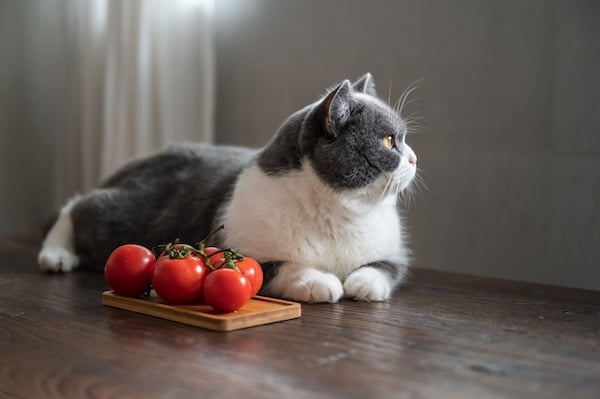- Not a substitute for professional veterinary help.
Has your cat ever shown interest in the diced tomato on your sandwich? Or the cherry tomato in your salad? Some cats may be curious about various human foods, and as a pet parent, it’s important to know which table scraps can cause digestive problems or other health issues.
So is it safe to let kitty taste test a bit of tomato? Dr. Kathleen Mottel, Assistant Managing DVM at Glen Ellyn Animal Hospital, explains: “In general, ripe tomatoes are not toxic to cats. There aren’t any health benefits from a cat eating a tomato, but if they eat a small amount from time to time, it’s typically okay.”
The tomato plant, however, is toxic to both cats and dogs, so it’s crucial to keep your pet from nibbling on your garden. “The plant itself and the small green tomatoes can cause an upset stomach, hypersalivation, and in rare cases may cause slow heart rate, dilated pupils, and weakness,” warns Dr. Mottel.
Before you share this juicy fruit with your furry friend, here’s what you need to know.
Are Any Tomato Products Safe for Cats?
Perhaps your feline found your bowl of pasta and scrounged a few licks of tomato sauce. Should you worry? The type of tomato, its form, and the amount ingested all play a part in determining if your cat is at risk for illness. Here’s what to know.
| Tomato Type | Okay for Cats? |
| Ripe tomatoes | Okay in small amounts |
| Cherry tomatoes | Okay in small amounts |
| Cooked tomatoes | Okay in small amounts without seasoning |
| Tomato sauce | No |
| Tomato soup | No |
| Tomato paste | No |
| Ketchup | No |
- Ripe tomatoes. Tomatoes aren’t an essential part of your cat’s diet, but a piece of a plain, ripe tomato usually won’t bother their stomach. Ripe tomatoes (red, rather than green) are okay for cats to eat occasionally in small amounts.
- Cherry tomatoes. Cherry tomatoes follow the same safety guidelines as other ripe tomatoes, as long as your cat doesn’t ingest the stems or leaves.
- Cooked tomatoes. Cooked tomatoes are safe for your kitty to try in small amounts as long as there are no seasonings.
- Tomato sauce. Be mindful of letting your cat sample tomato-based sauces that include high levels of sodium, sugars, and other additives. These ingredients may not be easily digestible in your pet’s stomach.
- Tomato soup. Like tomato sauce, soup versions can include many harmful ingredients for a cat’s fragile digestive system. It may also include garlic and onions, which are toxic to cats.
- Tomato paste. The additives in tomato paste may cause tummy problems for your cat—feeding them this treat may not be worth the risk.
- Ketchup. In addition to artificial sweeteners, many ketchup recipes include garlic and onion, making this a toxic snack for your pet.
According to Dr. Mottel, whether or not a trip to the vet is required will depend on what your cat ate, as well as the portion size. “Most cats won’t need to go to the vet unless they’ve ingested a large amount of something tomato-based,” she says. “However, a vet visit is worth your while if they have eaten a lot of the tomato plant or unripe, green tomatoes.”

chendongshan via iStock
Risks of Unripe Tomatoes
While a ripe tomato doesn’t pose significant health risks, unripe tomatoes and the plant itself contain two toxic substances: solanine and tomatine. A ripe tomato can be determined by its full coloring (typically red or red-orange), its soft skin, and its ability to come off the vine easily. A tomato that is firm and green is not ready to eat.
Signs that your cat has gotten hold of an unripe tomato or tomato plant include lethargy, drooling, vomiting, diarrhea, and trouble breathing. Symptoms may begin a few hours after ingestion but can also appear after a few days. Dr. Mottel recommends visiting your vet if you know or suspect that your cat has eaten something potentially dangerous.
What Should Cats Eat Instead?
Letting your cat nibble on a bit of ripe tomato or plain, cooked tomato-based food can be a periodic treat. As the health benefits are zero to none, however, there are plenty of other cat-friendly snacks that can diversify their menu. If you’re looking to please your curious cat’s palate, try the treats below:
- Frozen homemade cat treats with ingredients like tuna, paté, goat’s milk, and yogurt
- DIY Pumpkin push pops
- Cooked and unseasoned poultry such as chicken or turkey
- Occasional small amounts of fruits, including bananas, blueberries, strawberries, watermelon, and apples
- Plain, cooked vegetables such as broccoli, carrots, green beans, and spinach in moderate amounts
- Delicious and nutritious cat treats, ranging from freeze-dried minnows to soft and chewy chicken and turkey snacks



